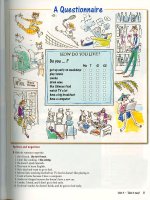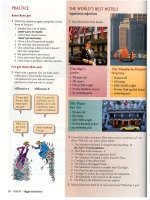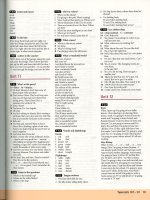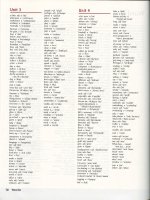Adapting the current textbook New Headway (Elementary) for students at Intermediate training level of Viet - Hung Industrial College
Bạn đang xem bản rút gọn của tài liệu. Xem và tải ngay bản đầy đủ của tài liệu tại đây (247.47 KB, 8 trang )
Adapting the current textbook New Headway
(Elementary) for students at Intermediate
training level of Viet - Hung Industrial College
42tr.
Nguyễn Thị Mai Dung
Trường Đại học Ngoại Ngữ
Luận văn ThS. Chuyên ngành: English Linguistics; Mã số: 60 22 15
Người hướng dẫn:
Năm bảo vệ: 2010
Keywords: Giáo trình; Tiếng Anh; Phương pháp dạy học
Content:
INTRODUCTION
1. Statement of problem and rationale for the study
"You can only learn what you already know”- Sufi Proverb.
It can be recognized that English now a day has no longer been the language of English
speaking countries but it has been becoming the dominant global language. This has been
changing considerably views and beliefs of teachers and learners in teaching and learning the
language. If the traditional belief that learning English must follow a “standard language” of
native speakers and the culture of them must be integrated into learning materials as a rigid
principle, it is now considered to be more flexible. The context issue of the teaching and learning
has never been taken into account so thoroughly like that before. The appearance of the terms
such as “teaching in context”, “learning in context”, “from communicative to context- based” etc
are evidences. Consequently, teaching and learning in local areas should be reviewed, especially
the use of course book as the central and nearly unique material in many colleges currently
should be changed to some extent.
Course book, also called textbook has been used commonly as the only learning material
in English classrooms in most Vietnamese colleges until now. Viet- Hung Industrial College
(VIC) is also among those. A pilot survey showed that there is 56% of students at the college use
the textbook as the unique learning material. It was seen through observations that 90% of the
classes used this material alone in acquiring English in class. The textbook, which is availably
designed and is taught commonly with available contents, has been causing many problems in
teaching and learning. The contexts in the lead-in phase of the book which were used to present
and practice the new language unrealistically have resulted in low effectiveness in learning.
While teachers “tend to teach the textbook itself, rather than use it as a resource for
creativity and inspiration, a learning tool for their learners and a means to an end in their
teaching (Cunningsworth, 1995: 139) is a big problem, there are many researchers who make
clear various problems with the material. O’Neill (1982: 153) suggests that the textbook can only
provide props and framework for classroom teaching; and no textbook can expect to appeal to all
teachers or learners at a particular level. McDonough and Shaw (1993: 83) also propose that
textbooks, internally coherent although they may be, they may not be totally applicable. Swales
(1980) contends that any given course book will be incapable of catering for the diversity of
needs which exists in most language classrooms. Allwright (1981: 9) also maintains that given
the complexity of the whole business of the management of language learning, even with the best
intentions no single textbook can possibly work in all situations. Sheldon (1988: 239) addresses
lack of cultural appropriateness of some textbooks, i.e. the thinking underlying the textbook
writing may be different from or in conflict with the assumptions held by the teachers. It is
obviously that using textbook as unique teaching material is no longer the good choice.
Indeed, although the teachers at the college have tried to apply new teaching methods as
well as improve their techniques in class teaching, their students still keep making mistakes and
unable to build their communicative skills. The boring and stressful atmosphere often covers
most English classes of students at intermediate level, who have low English proficiency when
they enter the college and always show less motivation to learn it. A pilot survey by the
researcher showed that one of the big difficulties for the students of this level is the context of
the lessons. Most of them said that they feel the context of the language is like something coming
from the sky and they cannot understand why they have to learn these strange things, what they
are going to do with these knowledge as they are looking forwards to finding a job as a worker or
a staff in a national company or factory.
Therefore the problem should be concerned by the teachers among many other problems
related to the ineffectiveness in English teaching. More specifically, textbook adaptation should
be considered an important and indispensable issue during language teaching process because it
is the teachers but not language experts who have “direct personal knowledge of their classroom
teaching” can understand their learners most and know the most suitable ways to meet the
learners’ demand.
In addition, adapting their materials allows the teachers to achieve more compatibility
and fitness between the textbook and the teaching environment, and maximize the value of the
book for the benefit of their particular learners and for the most effective teaching outcomes to
achieve. It would consequently lead to the improvement of the textbook in the sense of being
able to suit the particular situation and empowering and reskilling the teachers (Apple and
Jungck, 1990; Shannon, 1987). Richards (1998: 135) argues that teachers should approach
textbooks with the expectation that deletion, adaptation, and extension will be normally needed
for the materials to work effectively with their class.
Within the background above, the research was conducted to find out more effective way to
adapt the textbook in order to fit the particular learners’ learning. Through investigating on the
students and teacher’s evaluation on the textbook, truth could be revealed and used as a basis for
the adaptations at present and in the future. “In every problem there is a gift”, the saying of Jean
Zukowski/ Faust in a journal by Alan Seaman, Ph.D also an inspiration for the author to choose
this topic. The study really gives the researcher a chance to make theories into practice, improve
her skills in making teaching plans, and most of all make her teaching more effective.
2. Aims of the study
As mentioned from the above rationales, the study aims at finding out more effective way to
adapt the textbook in order to fit the learning of these particular learners. The specific aims of the
research are as follows:
To investigate students’ evaluations on the contexts of the current textbook.
To find out about students’ need on suitable contexts in their learning.
To create suitable contexts for the current textbook in order to help the learners access the
material more easily.
In order to achieve these aims, the study must answer three questions:
1. How do contexts in the current textbook cause difficulties for the learners?
2. What are the suitable contexts for the students to learn effectively?
3. How are these existing contexts adapted?
3. Significance of the study
In an attempt to bring scientific theories into practice in a particular teaching environment
and for particular learners, the study is one contribution to the non- stop innovation in teaching
methodology in the college. It brings new insights into the use of materials, especially use of
textbook in teaching English because there hasn’t been any research into textbook adaptation
applied in the college so far.
On the other hand, the study can also bring practical benefits to English teaching and learning
in the college. It provides useful and specific clues on designing suitable contexts for presenting
new language to the teachers who teach English for the learners of vocational training at
intermediate level. This adapting skill is considered to be very important for an EFL teacher in
teaching job at the college.
4. Scope of the study
As many language experts said, when we use a textbook for particular learners, there will be
so many inappropriateness of it that teachers should consider to adapt. For example, there are
common adaptations applied to textbook focus on activities, skills, methodology, texts etc. This
thesis aimed at studying the contexts of the course book which is currently used in the college of
the researcher. However, recognizing that the research topic is too large with so many types of
contexts designed in the textbook as well as the limitation of time allowed and the limited
number of pages, the study can only cover the kind of contexts that are used at the beginning of
each lesson to present new language. And because the contexts are used in the lead- in stage of
each lesson, the author contemporarily calls them “lead- in contexts” and presumes to use this
term throughout the next parts of the thesis. The study concerns these issues:
Briefly review the topic as well as the lead- in contexts of the textbook
Analyze students’ evaluations on the textbook concerning topics and contexts
Survey teachers’ use of the lead- in contexts in the textbook
Analyze students’ need on familiar learning contexts
Find out the most problematic lead- in contexts
Suggest some suitable lead- in contexts as samples for the adaptation
5. Method of the study
According to Huchinton and Waters (1987), the best methodology for studying the needs of
any particular group of students is to use such method as questionnaires, follow- up interviews,
and collection of authentic texts. Therefore, in order to find out answers to the research questions
mentioned above, a quantitative method in research was exploited to collect opinions about the
course book as well as the teachers and students’ attitudes towards the contexts, used to teach
new language at the beginning of each lesson in the textbook New Headway elementary.
Through the data collected from the questionnaire, truth value of persuasive statistics concerning
the investigated issues could be obtained. In addition, a follow- up interview, a qualitative
method in research, was undertaken to make the data clearer and more valuable.
On the other hand, information from other sources such as the Internet, journals and books
was collected, summarized, analyzed and synthesized. Collecting information and analyzing data
from other sources also equipped the researcher with background knowledge and literature of the
investigated issues.
Through analyzing the information and data collected, the researcher have flexibly taken
advantages of all the above mentioned methods as a source of evidence to enhance the
persuasive value of the study.
6. Design of the study
The paper includes four chapters altogether.
Chapter 1- Literature Review reviews theoretical background on which the whole study is
based on, including theoretical issues of using contexts in presenting new language.
Chapter 2- Methodology describes in detail the methods and procedures that the researcher
use in conducting this research.
Chapter 3- Data analysis and findings presents the results collected together with the
author’s discusses findings and possible inferences from such findings.
Chapter 4- Adapting contexts in the textbook New Headway elementary provides some
criteria for adapting the lead- in contexts of the textbook, some sample adapted contexts and
some suggestions for further study.
REFERENCES
Kirsten Malmkicer and John Williams. 1998. Context in Language Learning and Language
Understanding. Cambridge University Press
Ronal Carter and David Nunan. 2001. The Cambridge Guide to Teaching English to Speakers of
Other Languages. Cambridge University Press.
Cunningsworth, Allan. 1995. Choosing Your coursebook. Henle and Heinle .
Cunningsworth, (1984). Evaluating and Selecting EFL Teaching Materials. Heinemann.
Liz and John Soars, 2000, New Headway English Course- elementary. Oxford University Press.
Nunan, D. (1992). Research methods in language learning. Cambridge University Press.
Jo McDonough and Steven McDonough, 1997, Research Methods for English Language
Teachers, Arnold- A member of the Holder Headline Group, London.
Richards, J.C. 2001. Curriculum Development in Language Teaching. Cambridge University
Press 2001 from the World Wide Web a t />of-textbooks.pdf
Bao Zhixian, 2004. English Language Teaching, from the World Wide Web at









